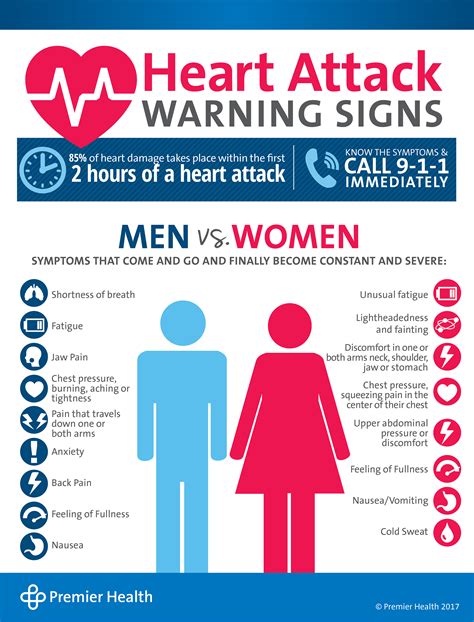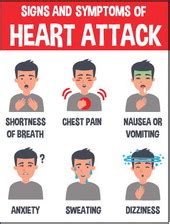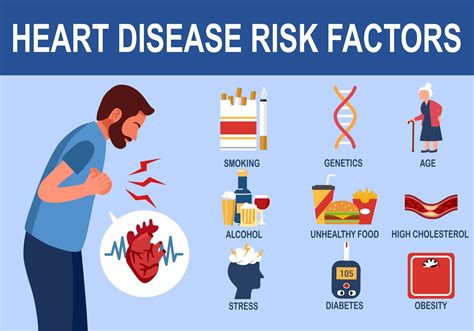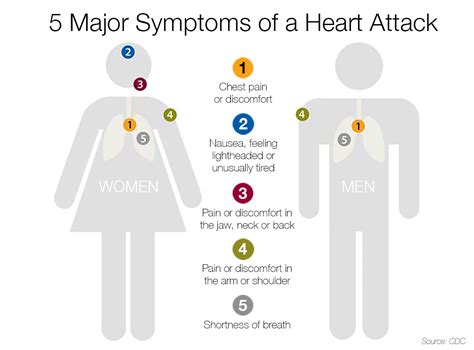Intro
Learn heart attack signs, symptoms, and warning signals, including cardiac arrest, chest pain, and shortness of breath, to promptly respond and save lives with timely medical intervention.
Heart attacks are a leading cause of death worldwide, and recognizing the signs of a heart attack can be a matter of life and death. Every year, millions of people suffer from heart attacks, and timely medical intervention can significantly improve survival rates. However, many people are unaware of the warning signs of a heart attack, which can lead to delayed treatment and increased risk of complications. In this article, we will delve into the importance of recognizing heart attack signs, the benefits of early detection, and the steps you can take to protect yourself and your loved ones.
A heart attack, also known as myocardial infarction, occurs when the blood flow to the heart is blocked, causing damage to the heart muscle. The blockage is usually due to a blood clot that forms in a coronary artery, which supplies blood to the heart. When the blood flow is blocked, the heart muscle becomes damaged, and if the blockage is not treated promptly, it can lead to permanent damage or even death. Recognizing the signs of a heart attack is crucial, as timely medical treatment can help restore blood flow to the heart, reduce damage, and improve survival rates.
The importance of recognizing heart attack signs cannot be overstated. According to the American Heart Association, prompt medical treatment can reduce the risk of death from a heart attack by up to 50%. Moreover, early detection and treatment can also reduce the risk of complications, such as heart failure, arrhythmias, and cardiac arrest. Therefore, it is essential to be aware of the warning signs of a heart attack and to take immediate action if you or someone you know is experiencing symptoms.
Understanding Heart Attack Signs

Recognizing heart attack signs requires knowledge of the common symptoms and warning signs. The most common symptoms of a heart attack include chest pain or discomfort, shortness of breath, nausea, lightheadedness, and fatigue. However, not all heart attacks present with these typical symptoms, and some people may experience atypical symptoms, such as back pain, jaw pain, or arm pain. It is essential to be aware of these symptoms and to seek medical attention immediately if you or someone you know is experiencing them.
Common Symptoms of a Heart Attack
The common symptoms of a heart attack include: * Chest pain or discomfort: This is the most common symptom of a heart attack and can feel like pressure, tightness, or heaviness in the chest. * Shortness of breath: People experiencing a heart attack may feel short of breath or have difficulty breathing. * Nausea: Nausea and vomiting are common symptoms of a heart attack, especially in women. * Lightheadedness: People experiencing a heart attack may feel lightheaded or dizzy. * Fatigue: Unusual fatigue or weakness can be a symptom of a heart attack.Atypical Symptoms of a Heart Attack

Atypical symptoms of a heart attack can be misleading, as they may not be immediately recognized as symptoms of a heart attack. These symptoms include:
- Back pain: Some people may experience back pain or discomfort, which can be a symptom of a heart attack.
- Jaw pain: Jaw pain or discomfort can be a symptom of a heart attack, especially in women.
- Arm pain: Pain or discomfort in the arms, especially the left arm, can be a symptom of a heart attack.
- Stomach pain: Some people may experience stomach pain or discomfort, which can be a symptom of a heart attack.
Risk Factors for Heart Attack
Certain risk factors can increase the likelihood of a heart attack. These risk factors include: * High blood pressure * High cholesterol * Smoking * Diabetes * Family history of heart disease * Obesity * Lack of physical activity * StressReducing the Risk of Heart Attack

Reducing the risk of heart attack requires a combination of lifestyle changes and medical interventions. Some ways to reduce the risk of heart attack include:
- Quitting smoking
- Exercising regularly
- Eating a healthy diet
- Managing stress
- Getting enough sleep
- Monitoring and controlling blood pressure and cholesterol levels
- Managing diabetes
Medical Interventions for Heart Attack
Medical interventions for heart attack include: * Medications: Medications such as aspirin, beta blockers, and ACE inhibitors can help reduce the risk of heart attack. * Angioplasty: Angioplasty is a procedure that involves inserting a catheter into the blocked artery to restore blood flow. * Bypass surgery: Bypass surgery involves grafting a healthy blood vessel onto the blocked artery to restore blood flow.What to Do in Case of a Heart Attack

If you or someone you know is experiencing symptoms of a heart attack, it is essential to take immediate action. Here are some steps to follow:
- Call emergency services: Call 911 or your local emergency number immediately if you or someone you know is experiencing symptoms of a heart attack.
- Provide information: Provide as much information as possible to the emergency operator, including the location and the symptoms being experienced.
- Administer CPR: If the person experiencing the heart attack is unconscious, begin CPR if you are trained to do so.
- Take medication: If the person experiencing the heart attack is taking medication, such as nitroglycerin, help them take it as directed.
Recovering from a Heart Attack
Recovering from a heart attack requires a combination of medical interventions and lifestyle changes. Some ways to recover from a heart attack include: * Following a rehabilitation program: A rehabilitation program can help you recover from a heart attack and reduce the risk of future heart problems. * Making lifestyle changes: Making lifestyle changes, such as quitting smoking, exercising regularly, and eating a healthy diet, can help reduce the risk of future heart problems. * Managing stress: Managing stress through techniques such as meditation and deep breathing can help reduce the risk of future heart problems.Conclusion and Next Steps

Recognizing heart attack signs is crucial for timely medical intervention and reducing the risk of complications. By understanding the common and atypical symptoms of a heart attack, reducing the risk of heart attack through lifestyle changes and medical interventions, and taking immediate action in case of a heart attack, you can help protect yourself and your loved ones from the devastating effects of a heart attack. We encourage you to share this article with your friends and family, and to take the necessary steps to reduce your risk of heart attack.
What are the most common symptoms of a heart attack?
+The most common symptoms of a heart attack include chest pain or discomfort, shortness of breath, nausea, lightheadedness, and fatigue.
How can I reduce my risk of heart attack?
+You can reduce your risk of heart attack by quitting smoking, exercising regularly, eating a healthy diet, managing stress, and getting enough sleep.
What should I do if someone I know is experiencing symptoms of a heart attack?
+If someone you know is experiencing symptoms of a heart attack, call emergency services immediately and provide as much information as possible. If the person is unconscious, begin CPR if you are trained to do so.
